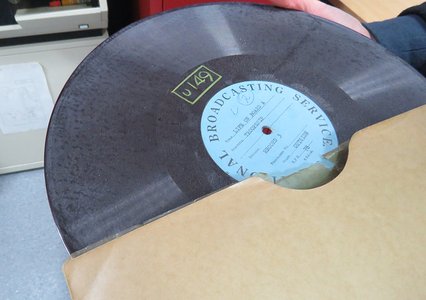
A collection of nearly 1,600 audio discs made for New Zealand radio during World War Two has been recognised by the United Nations as taonga of significant cultural value. The discs, along with four other documentary collections, are to be inscribed in the UNESCO Memory of the World Register at a ceremony in Wellington today.
The 1,592 fragile discs are preserved in the archive of Ngā Taonga Sound & Vision and are described as an invaluable record of the voices of New Zealanders at war. They were recorded by the National Broadcasting Service (the forerunner of Radio New Zealand) in its ground-breaking Mobile Unit in North Africa, the Middle East, Italy and the Pacific between 1940 and 1945.
As well as action reports on military engagements and other talks or interviews with service personnel, the recordings feature hundreds of ‘messages home’ by ordinary servicemen and women, sending greetings to their loved ones back in New Zealand.
UNESCO’s Memory of the World Register recognises items of documentary heritage which have worldwide significance in the same way that its World Heritage Convention and World Heritage List recognise significant natural and cultural sites. The inscription therefore gives the disc collection a similar cultural status to places such as the city of Venice, the Grand Canyon or Rapa Nui/Easter Island.
Honiana Love, Tumu Whakarae - Chief Executive of Ngā Taonga Sound & Vision says: “The World War Two Mobile Unit recordings capture the voices of New Zealanders at war, thousands of miles from home. These 1,500 discs are an invaluable historic record that captures how we fought, but also how we spoke, sang and communicated with our loved ones from far away, at a time of great crisis. Ngā Taonga Sound & Vision is proud to be caring for these taonga and working to make them available for generations of New Zealanders to hear.”
The creation of the Mobile Broadcast Unit in 1940 marked a watershed moment in New Zealand broadcasting history. The National Broadcasting Service had only invested in recording technology five years earlier, and the Mobile Unit took New Zealand broadcasting out of the radio studio and into the outside world for the first time.
In doing so they also began to democratise broadcasting in New Zealand because the voices that we hear are not just those of generals and leaders, but personnel of all ranks, from infantrymen and sailors to cooks and drivers. The human heart of this collection is the huge number of ‘messages home’, the voices of ordinary soldiers and sailors and a few nurses, sending thoughts back to loved ones in New Zealand. It has been estimated that almost 10 percent of New Zealand personnel who served with the New Zealand Division during the war were recorded by the Mobile Unit.
Many of the Māori speakers give their reports or messages home in te reo Māori – a valuable record of mita or dialects which are now being revived by iwi. The voices and performances of the men of the 28th Māori Battalion are especially treasured as taonga Māori.
For many hundreds of the speakers, these discs are the only record of them and their part in the war. For many New Zealand families, these are the only record of the voice of a departed family member. To some people they are the only sound of their father’s voice they have ever heard, having been born while they were away on military service from which they did not return.
Especially poignant are the recordings of 65 New Zealanders who served with the Royal Navy on the cruiser HMS Neptune, which was destroyed by a mine in the Mediterranean in December 1941, only a few weeks after the men recorded messages home with the Mobile Unit.
The survival of these discs is remarkable in itself, given the fragility of the recording medium, never intended for long-term archiving. Most of the discs are made of aluminium with a thin layer of acetate lacquer, onto which the sound recordings were directly etched. At a time before magnetic tape this was the only means of recording sound. The discs are highly susceptible to expansion and contraction in fluctuating temperatures, often cracking the brittle lacquer.
Having been recorded in the hot climate of North Africa and the Middle East, and then shipped or flown back to New Zealand, it is a miracle that so many of them have survived in a playable condition. Sound archivists at Ngā Taonga Sound & Vision are painstakingly digitising the discs, which are now stored in temperature-controlled vaults at Avalon in Lower Hutt. More information about this process is covered in this blog.
Four other documentary collections, from Auckland Libraries, the Hocken Collections and the Alexander Turnbull Library, are also inscribed in the UNESCO Register today. Full details can be found on the UNESCO website.
Hero image: a disc from the U Series